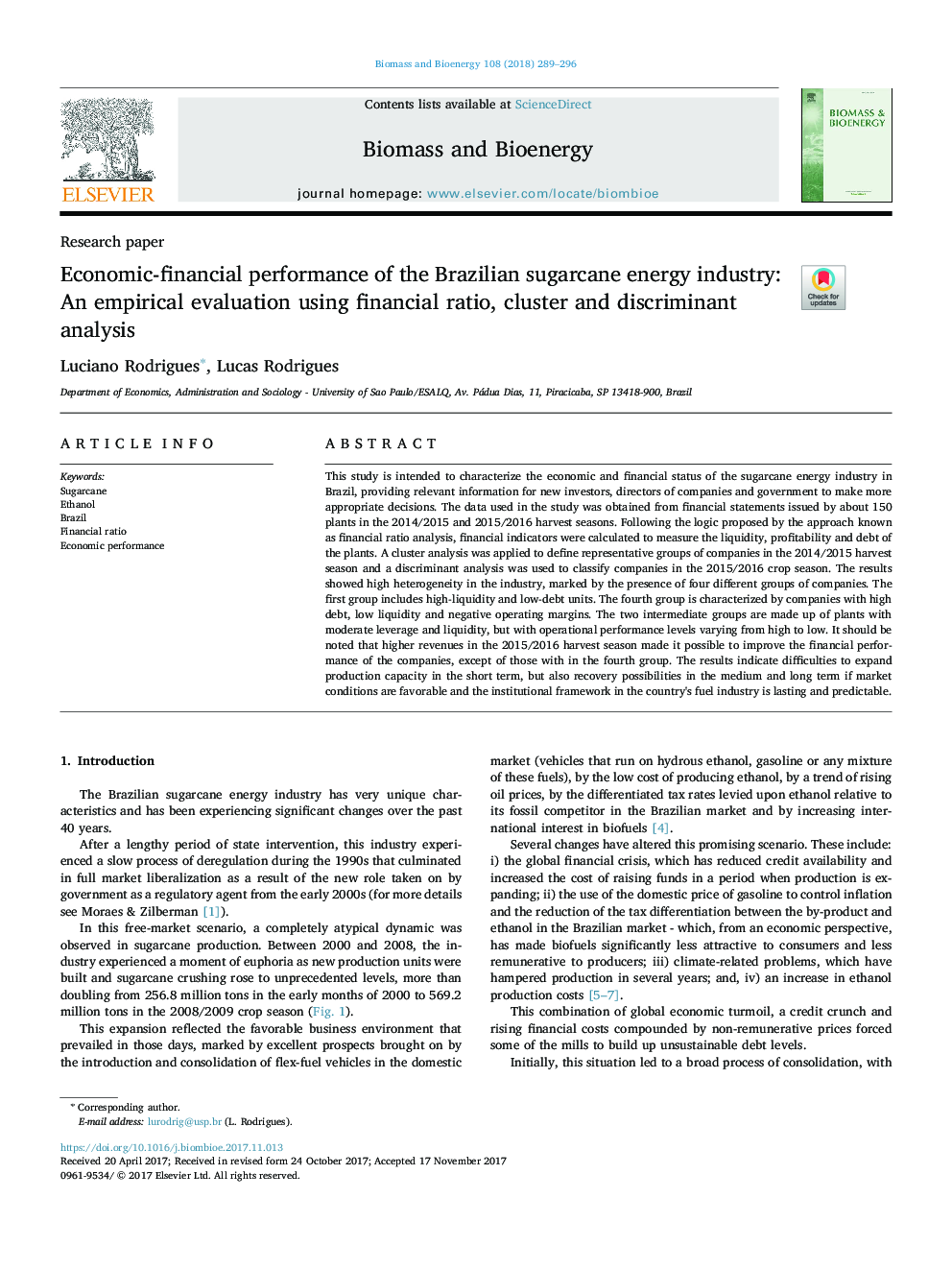| کد مقاله | کد نشریه | سال انتشار | مقاله انگلیسی | نسخه تمام متن |
|---|---|---|---|---|
| 7063067 | 1459785 | 2018 | 8 صفحه PDF | دانلود رایگان |
عنوان انگلیسی مقاله ISI
Economic-financial performance of the Brazilian sugarcane energy industry: An empirical evaluation using financial ratio, cluster and discriminant analysis
ترجمه فارسی عنوان
عملکرد اقتصادی در صنعت انرژی نیشکر در برزیل: ارزیابی تجربی با استفاده از نسبت مالی، تجزیه و تحلیل خوشه ای و تجزیه و تحلیل
دانلود مقاله + سفارش ترجمه
دانلود مقاله ISI انگلیسی
رایگان برای ایرانیان
کلمات کلیدی
نیشکر، اتانول، برزیل، نسبت مالی، عملکرد اقتصادی،
ترجمه چکیده
این مطالعه به منظور تعریف وضعیت اقتصادی و مالی صنعت انرژی نیشکر در برزیل، ارائه اطلاعات مربوط به سرمایه گذاران جدید، مدیران شرکت ها و دولت برای تصمیم گیری مناسب تر است. داده های مورد استفاده در این مطالعه از صورتهای مالی صادر شده توسط حدود 150 گیاه در فصل های برداشت 2014/2015 و 2015/2016 بدست آمده است. به دنبال منطق پیشنهاد شده توسط روش شناخته شده به عنوان تجزیه و تحلیل نسبت مالی، شاخص های مالی برای اندازه گیری نقدینگی، سودآوری و بدهی گیاهان محاسبه شد. تجزیه و تحلیل خوشه ای برای تعریف گروه های نمایشی شرکت ها در فصل برداشت 2014/2015 صورت گرفت و برای طبقه بندی شرکت ها در فصل محصولات 2015/2016 از تجزیه و تحلیل جدایی استفاده شد. نتایج نشان داد ناهمگونی زیاد در صنعت، مشخص شده با حضور چهار گروه مختلف از شرکت ها. گروه اول شامل واحدهای دارای نقدینگی و کمبود بدهی می باشد. گروه چهارم، شرکت هایی با بدهی های بالا، نقدینگی کم و حاشیه های عملکرد منفی مشخص می شود. دو گروه متوسط عبارتند از گیاهان با اهرم متوسط و نقدینگی، اما با سطوح عملکرد عملیاتی متفاوت از بالا به پایین. لازم به ذکر است که درآمد های بالاتر در فصل برداشت 2015/2016 موجب بهبود عملکرد مالی شرکت ها شد، به استثنای کسانی که در گروه چهارم قرار دارند. نتایج نشان می دهد که مشکلات در افزایش ظرفیت تولید در کوتاه مدت، اما همچنین فرصت های بازسازی در شرایط متوسط و بلند مدت، اگر شرایط بازار مطلوب باشند، چارچوب نهادی در صنعت سوخت کشور، پایدار و قابل پیش بینی است.
موضوعات مرتبط
مهندسی و علوم پایه
مهندسی شیمی
تکنولوژی و شیمی فرآیندی
چکیده انگلیسی
This study is intended to characterize the economic and financial status of the sugarcane energy industry in Brazil, providing relevant information for new investors, directors of companies and government to make more appropriate decisions. The data used in the study was obtained from financial statements issued by about 150 plants in the 2014/2015 and 2015/2016 harvest seasons. Following the logic proposed by the approach known as financial ratio analysis, financial indicators were calculated to measure the liquidity, profitability and debt of the plants. A cluster analysis was applied to define representative groups of companies in the 2014/2015 harvest season and a discriminant analysis was used to classify companies in the 2015/2016 crop season. The results showed high heterogeneity in the industry, marked by the presence of four different groups of companies. The first group includes high-liquidity and low-debt units. The fourth group is characterized by companies with high debt, low liquidity and negative operating margins. The two intermediate groups are made up of plants with moderate leverage and liquidity, but with operational performance levels varying from high to low. It should be noted that higher revenues in the 2015/2016 harvest season made it possible to improve the financial performance of the companies, except of those with in the fourth group. The results indicate difficulties to expand production capacity in the short term, but also recovery possibilities in the medium and long term if market conditions are favorable and the institutional framework in the country's fuel industry is lasting and predictable.
ناشر
Database: Elsevier - ScienceDirect (ساینس دایرکت)
Journal: Biomass and Bioenergy - Volume 108, January 2018, Pages 289-296
Journal: Biomass and Bioenergy - Volume 108, January 2018, Pages 289-296
نویسندگان
Luciano Rodrigues, Lucas Rodrigues,
